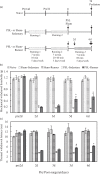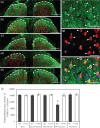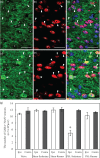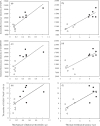Improvements in impaired GABA and GAD65/67 production in the spinal dorsal horn contribute to exercise-induced hypoalgesia in a mouse model of neuropathic pain
- PMID: 27030712
- PMCID: PMC4956002
- DOI: 10.1177/1744806916629059
Improvements in impaired GABA and GAD65/67 production in the spinal dorsal horn contribute to exercise-induced hypoalgesia in a mouse model of neuropathic pain
Abstract
Background: Physical exercise effectively attenuates neuropathic pain, and multiple events including the inhibition of activated glial cells in the spinal dorsal horn, activation of the descending pain inhibitory system, and reductions in pro-inflammatory cytokines in injured peripheral nerves may contribute to exercise-induced hypoalgesia. Since fewer GABAergic hypoalgesic interneurons exist in the dorsal horn in neuropathic pain model animals, the recovery of impaired GABAergic inhibition in the dorsal horn may improve pain behavior. We herein determined whether the production of gamma-aminobutyric acid (GABA) and glutamic acid decarboxylase (GAD) in the dorsal horn is restored by treadmill running and contributes to exercise-induced hypoalgesia in neuropathic pain model mice. C57BL/6 J mice underwent partial sciatic nerve ligation (PSL). PSL-Runner mice ran on a treadmill at 7 m/min for 60 min/day, 5 days/week, from two days after PSL.
Results: Mechanical allodynia and heat hyperalgesia developed in PSL-Sedentary mice but were significantly attenuated in PSL-Runner mice. PSL markedly decreased GABA and GAD65/67 levels in neuropils in the ipsilateral dorsal horn, while treadmill running inhibited these reductions. GABA+ neuronal nuclei+ interneuron numbers in the ipsilateral dorsal horn were significantly decreased in PSL-Sedentary mice but not in PSL-Runner mice. Pain behavior thresholds positively correlated with GABA and GAD65/67 levels and GABAergic interneuron numbers in the ipsilateral dorsal horns of PSL-Sedentary and -Runner mice.
Conclusions: Treadmill running prevented PSL-induced reductions in GAD65/67 production, and, thus, GABA levels may be retained in interneurons and neuropils in the superficial dorsal horn. Therefore, improvements in impaired GABAergic inhibition may be involved in exercise-induced hypoalgesia.
Keywords: Gamma-aminobutyric acid; exercise-induced hypoalgesia; glutamic acid decarboxylase; neuropathic pain; treadmill running.
© The Author(s) 2016.
Figures





References
-
- Bobinski F, Martins DF, Bratti T, et al. Neuroprotective and neuroregenerative effects of low-intensity aerobic exercise on sciatic nerve crush injury in mice. Neuroscience 2011; 194: 337–348. - PubMed
-
- Chen YW, Li YT, Chen YC, et al. Exercise training attenuates neuropathic pain and cytokine expression after chronic constriction injury of rat sciatic nerve. Anesth Analg 2012; 114: 1330–1337. - PubMed
-
- Cobianchi S, Casals-Diaz L, Jaramillo J, et al. Differential effects of activity dependent treatments on axonal regeneration and neuropathic pain after peripheral nerve injury. Exp Neurol 2013; 240: 157–167. - PubMed
-
- Korb A, Bonetti LV, da Silva SA, et al. Effect of treadmill exercise on serotonin immunoreactivity in medullary raphe nuclei and spinal cord following sciatic nerve transection in rats. Neurochem Res 2010; 35: 380–389. - PubMed
-
- Shankarappa SA, Piedras-Renteria ES, Stubbs EB., Jr Forced-exercise delays neuropathic pain in experimental diabetes: effects on voltage-activated calcium channels. J Neurochem 2011; 118: 224–236. - PubMed
Publication types
MeSH terms
Substances
LinkOut - more resources
Full Text Sources
Other Literature Sources
Miscellaneous

